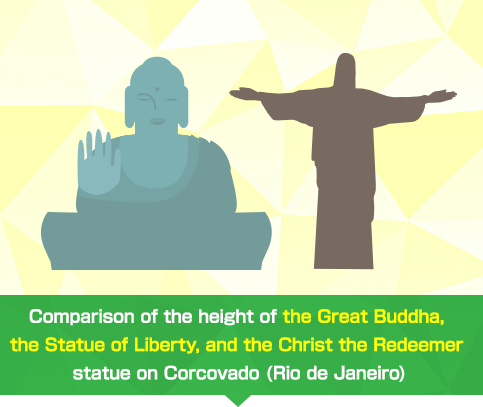Go Deeper! Nara's Historical and Cultural Resources
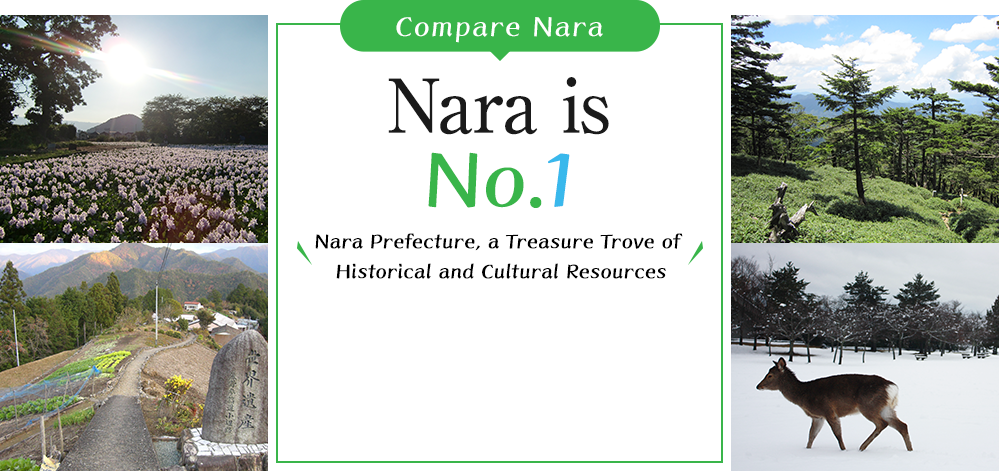 Nara Prefecture has the largest number of sculptures and structures designated as National Treasures in Japan, and also boasts the most Historic Sites, Places of Scenic Beauty, and Natural Monuments in the country. Come experience history in Nara, the number one prefecture for immersing yourself in Japan’s past!
Nara Prefecture has the largest number of sculptures and structures designated as National Treasures in Japan, and also boasts the most Historic Sites, Places of Scenic Beauty, and Natural Monuments in the country. Come experience history in Nara, the number one prefecture for immersing yourself in Japan’s past!
 Nara in Numbers
Nara in Numbers

The Great Buddha of Nara has a height of about 15 meters, the Statue of Liberty about 34 meters (up to the head and excluding the pedestal), and the Christ the Redeemer on Corcovado (Brazil) about 30 meters (excluding the pedestal). This makes the Great Buddha a lot smaller, right? Not so fast! The Great Buddha’s height of about 15 meters is his seated height. No one can tell how tall he really is because he is sitting down. Just imagine how he would look if he were to stand up!
Suzaku-oji street, once the main street of the former capital of Japan Heian-kyo, has a width of approximately 70 meters. The runway of Kansai International Airport is approximately 60 meters wide, which means that Suzaku-oji street is wide enough for a jumbo jet to land with room to spare. Although there were no jumbo jets in service in ancient times, one of the ways to enjoy history is to let one’s imagination run free across the ages.
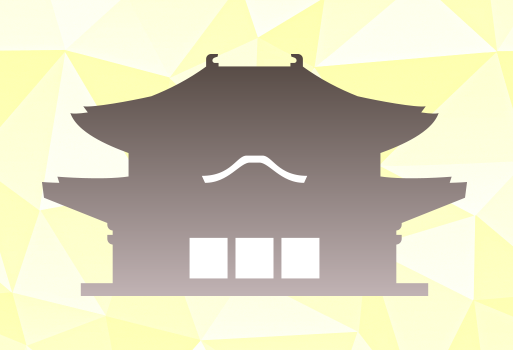
This set of words refers to the three tallest buildings in ancient Japan. It appears in Kuchizusami, an educational children’s book written in the mid-Heian period (794-1185), and was a mnemonic used to help children remember the names of these buildings in order. Un(ta) refers to Izumo-Taisha Shrine, wa(ni) to the Great Buddha Hall of Todai-ji Temple in Yamato Province, and kyo(san) to Daigokuden in the Kyoto Imperial Palace. The Chinese characters “ta”, “ni”, and “san” are used to mean “first,” “second,” and “third”, respectively. Since Izumo-Taisha Shrine is said to have been about 48 meters high in ancient times, the Great Buddha Hall of Todai-ji Temple must have been known as the second largest after Izumo-Taisha Shrine.
 Nara, a Treasure Trove of
Nara, a Treasure Trove of
Historical and Cultural Resources

Nara Prefecture, once the political, economic, and cultural heartland of Japan, was home to the ancient capitals of Asuka-Fujiwara and Heijo-kyo, and has continued to grow along with its rich history. There are numerous historical and cultural resources throughout Nara, including many National Treasures and Important Cultural Properties. What’s more, three of Japan’s 25 UNESCO World Heritage properties are located in Nara (Buddhist Monuments in the Horyu-ji Area, Historic Monuments of Ancient Nara, and Sacred Sites and Pilgrimage Routes in the Kii Mountain Range), while “Asuka-Fujiwara: Archaeological Sites of Japan’s Ancient Capitals and Related Properties” has been placed on the tentative list. Nara is truly a treasure trove of historical and cultural resources of global significance.
(Updated March 1, 2023)
 World Heritage
World Heritage

25 properties in Japan have been inscribed on the UNESCO World Heritage list, three of which are located in Nara (Buddhist Monuments in the Horyu-ji Area, Historic Monuments of Ancient Nara, and Sacred Sites and Pilgrimage Routes in the Kii Mountain Range). In addition, “Asuka-Fujiwara: Archaeological Sites of Japan’s Ancient Capitals” has been placed on the tentative list.
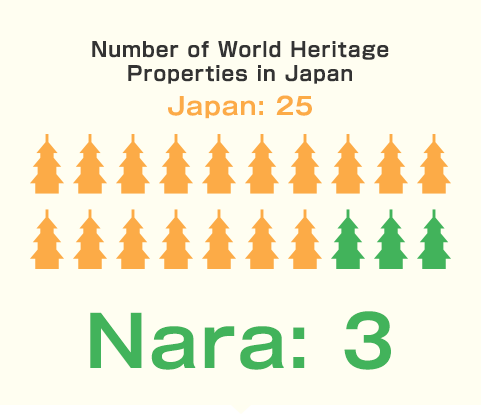
World Heritage refers to properties inscribed on the World Heritage List in accordance with the World Heritage Convention adopted by the United Nations Educational, Scientific and Cultural Organization (UNESCO). The World Heritage List includes cultural and natural heritage that is of Outstanding Universal Value to humanity as a whole.
(Updated March 2023)
 National Treasures and Important Cultural Properties
National Treasures and Important Cultural Properties

Taken together, Nara Prefecture has 1,331 National Treasures and Important Cultural Properties, ranking third in Japan.
(1st: Tokyo; 2nd: Kyoto)
Nara Prefecture ranks first in Japan in terms of the number of sculptures and structures designated as National Treasures.
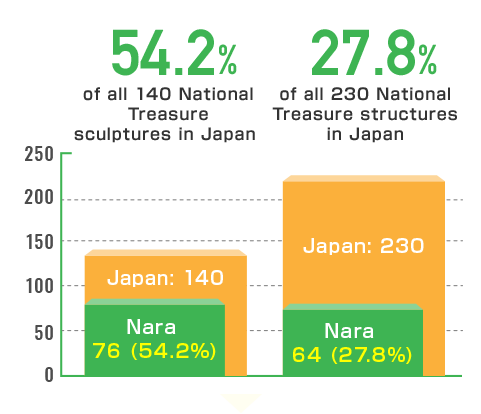
Important Cultural Properties are designated by the Minister of Education, Culture, Sports, Science and Technology as cultural properties of particular value from artistic, academic, and other perspectives, such as paintings, structures, crafts, archaeological materials, and structures. Among Important Cultural Properties, those designated by the Minister as having particularly high cultural, historical, and academic value are called National Treasures.
Source: Agency for Cultural Affairs, List of National Treasures and Important Cultural Properties by Prefecture
(Updated March 1, 2023)
 Historic Sites, Places of Scenic Beauty,
Historic Sites, Places of Scenic Beauty,
and Natural Monuments

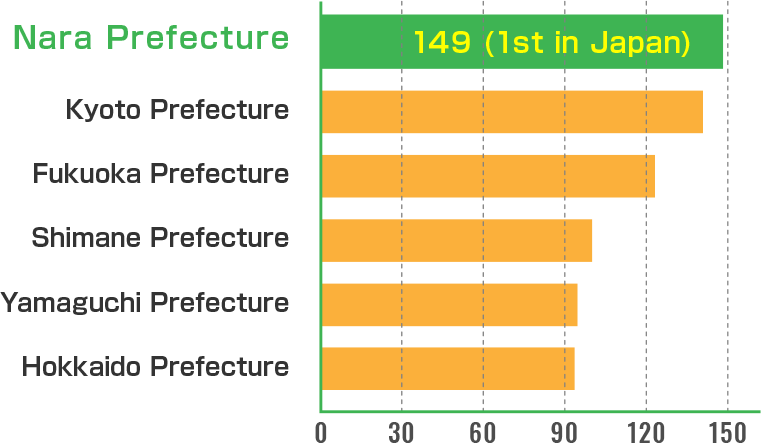
Nara Prefecture ranks first in Japan in terms of the number of Historic Sites, Places of Scenic Beauty, and Natural Monuments, with 149 such sites.
Historic Sites, Places of Scenic Beauty, and Natural Monuments is a collective term that includes monuments and ruins (Historic Sites), scenic spots (Places of Scenic Beauty), and animals, plants, and geological minerals (Natural Monuments). The Minister of Education, Culture, Sports, Science and Technology designates sites that are judged to be of high value from the standpoints of history, science, art, and aesthetic appreciation.
Source: Agency for Cultural Affairs, List of National Treasures and Important Cultural Properties by Prefecture
(Updated March 1, 2023)

